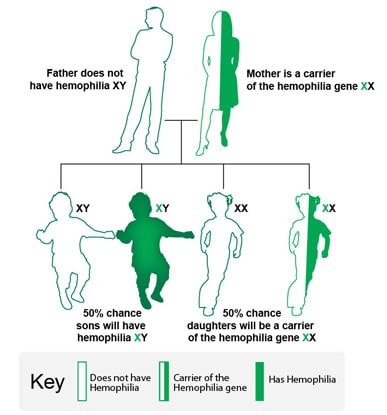Hemophilia is probably the most well-known disorder of bleeding. It is characterized by the fact that severe symptoms of bleeding only occur in boys, but it is passed on in families through women. As such, it is known as an X-linked disease and affects 1 in every 5,000 boys that are born. It is recognized now that the women are the carriers of the disease, but not all are without symptoms of bleeding. The bleeding condition has been recognized all through the written history of mankind and is most well known due to the fact that it affected the Royal families of Europe starting with the offspring of Queen Victoria of England. Tsarevich Alexis Romanov of the Russian Empire inherited the condition and came under the care of Rasputin. Rasputin used his influence on the family in brutal ways and contributed to the fall of the Romanov family and the Russian Empire.
Hemophilia is caused by a mutation of the chromosomes that causes those affected to be unable to make enough functioning Factor 8 or Factor 9. These factors are key proteins in the body’s mechanism to form a clot, therefore a clot does not form properly and bleeding becomes prolonged and severe. Hemophilia can be treated in several different ways based upon the severity of the bleeding. Treatment of the area that is bleeding can be effective when the bleeding is mild. There are also medicines that patients may take as a nasal spray or by mouth (Stimate ®, aminocaproic acid, tranexamic acid) to help decrease bleeding when it is more severe. Ultimately, there are replacement products that are put into patients’ veins that can replace the missing factor. These are used with very severe or difficult to control bleeding episodes, and in patients who have more severe disease and bleed frequently, they are used to prevent bleeding and the long-term injuries that may occur.
The factor products used today are extremely safe, but this has not always been the case. When HIV and AIDS were first recognized, the hemophilia population was first affected and most devastated. In the late 1970s and early 1980s, all factors were made from the donation of human plasma. The factor supply quickly became contaminated and overwhelming numbers of hemophilia patients receiving those products became infected. The HIV epidemic was quickly followed by an epidemic of Hepatitis B and Hepatitis C in the blood supply. Ryan White, a hemophiliac living in Indiana who became infected, used his condition to spur on the development of effective screening of the blood supply and the creation of the drugs used to treat HIV today. Sadly, Ryan White lost his fight against the infection in 1990, as so many other hemophiliacs have. The hemophilia community responded by demanding the creation of the recombinant products that are most widely used today.
The future is bright for hemophilia patients. New options for treatment have made infusion with replacement products safer, easier, and more convenient. Therapies that are arriving currently and are on the horizon include new treatments that can allow factor replacement to be given less often with fewer side effects. One day the factors may actually be taken as a pill form or a much simpler under the skin injection. There is even more hope that the technology of gene therapy and gene editing will offer a cure to those affected within this generation.



